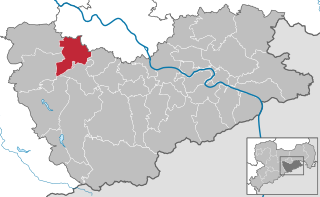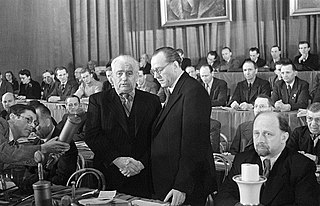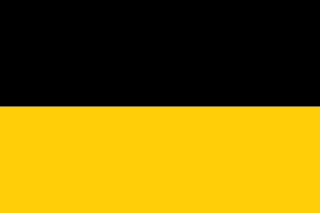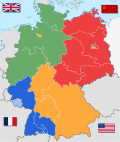
Saxony, officially the Free State of Saxony, is a landlocked state of Germany, bordering the states of Brandenburg, Saxony-Anhalt, Thuringia, Bavaria, as well as the countries of Poland and the Czech Republic. Its capital is Dresden, and its largest city is Leipzig. Saxony is the tenth largest of Germany's sixteen states, with an area of 18,413 square kilometres (7,109 sq mi), and the sixth most populous, with more than 4 million inhabitants.

Saxony-Anhalt is a state of Germany, bordering the states of Brandenburg, Saxony, Thuringia and Lower Saxony. It covers an area of 20,451.7 square kilometres (7,896.4 sq mi) and has a population of 2.17 million inhabitants, making it the 8th-largest state in Germany by area and the 11th-largest by population. Its capital is Magdeburg and its largest city is Halle (Saale).

Lusatia is a historical region in Central Europe, territorially split between Germany and Poland. Lusatia stretches from the Bóbr and Kwisa rivers in the east to the Pulsnitz and Black Elster rivers in the west, and is located within the German states of Saxony and Brandenburg as well as in the Polish voivodeships of Lower Silesia and Lubusz. Major rivers of Lusatia are the Spree and the Lusatian Neisse, which defines the border between Germany and Poland. The Lusatian Mountains of the Western Sudetes separate Lusatia from Bohemia in the south. Lusatia is traditionally divided into Upper Lusatia, the hilly southern part, and Lower Lusatia, the flat northern part.

Dr. Erhard Hübener was a German politician and member of the German Democratic Party (DDP) until 1933. After World War II he engaged in rebuilding structures of self-rule in the Soviet occupation zone and was a co-founder and member of the Liberal Democratic Party of Germany (LDPD).
The Soviet Military Administration in Germany was the Soviet military government, headquartered in Berlin-Karlshorst, that directly ruled the Soviet occupation zone of Germany from the German surrender in May 1945 until after the establishment of the German Democratic Republic (GDR) in October 1949.

The Soviet occupation zone in Germany was an area of Germany that was occupied by the Soviet Union as a communist area, established as a result of the Potsdam Agreement on 1 August 1945. On 7 October 1949 the German Democratic Republic (GDR), commonly referred to in English as East Germany, was established in the Soviet occupation zone.

The Landtag of Saxony, also known in English as the Saxon State Parliament, is the legislature of the Free State of Saxony, one of Germany's sixteen states. It is responsible for legislation, control of the government, and electing some state officials. The Landtag has existed in various forms since 1831, but the current body was established during German reunification in 1990. The Landtag is directly elected and has a term of five years.

Bad Muskau is a spa town in the historic Upper Lusatia region in Germany, at the border with Poland. It is part of the Görlitz district in the State of Saxony.

Freital is a town in the district of Sächsische Schweiz-Osterzgebirge in Saxony, Germany. The town is situated on a small river, the Weißeritz, and is eight kilometres (5 mi) southwest of Dresden.

The Diocese of Dresden–Meissen is a Latin Church diocese of Catholic Church in Germany with its seat in Dresden. It is suffragan to the Archdiocese of Berlin.

The Diocese of Görlitz is a Latin Church diocese of the Catholic church in Germany. The current ordinary is Wolfgang Ipolt

Max Seydewitz was a German politician. Between 1947 and 1952 he was the Minister-President of Saxony in the German Democratic Republic.
The German People's Congress were a series of congresses held in Germany. They consisted of members of the Socialist Unity Party, the SED, and other political parties and mass organizations. Delegates from all over Germany gathered for the first time on 6 December 1947. Their main demand was the establishment of a German government.

The East German branches of the Communist Party of Germany (KPD) and the Social Democratic Party of Germany (SPD) merged to form the Socialist Unity Party of Germany (SED) on 21 April 1946 in the territory of the Soviet occupation zone. It is considered a forced merger. In the course of the merger, about 5,000 Social Democrats who opposed it were detained and sent to labour camps and jails.

Hugo Hickmann was a German politician.
Gerhard Rohner was a politician in the Soviet occupation zone of Germany, which later became the German Democratic Republic. He became a leading member of the moderately right-wing CDU (party) which was not the party favored by the Soviet administrators and the new Moscow trained political establishment. After sustained violent attacks from the new country's ruling SED (party) he abandoned his political career and, in February 1952, fled the country.
Grete Groh-Kummerlöw was a German politician.

The State of Saxony-Anhalt was a subdivision of the Soviet occupation zone and state of East Germany which broadly corresponds with the present-day German state Saxony-Anhalt. After the retreat of the US troops from the Western parts - following the agreements of the Yalta Conference - it was formed as administrative division called Province of Saxony by the Soviet Military Administration in Germany (SMAD) in July 1945. The province was a re-establishment of the Province of Saxony which existed in Prussia from 1816 to 1944. On 1 July 1944, the Province of Saxony was divided along the lines of its three government districts of Halle-Merseburg, Magdeburg and Erfurt. The two provinces became part of the new state including small parts of Thuringia (Allstedt) and Soviet-occupied parts of Anhalt (Dessau) and Brunswick. Following the first election for the Landtag in October 1946, the state was renamed to Province of Saxony-Anhalt on the same day. With the abolition of Prussia in February 1947, it was named State of Saxony-Anhalt. Compared to the administrative divisions of Nazi Germany, it comprised the Gaue Magdeburg-Anhalt, Halle-Merseburg and small parts of Southern Hanover-Brunswick and Thuringia.
Max Silbermann was a German politician. He served as a member of the Saxon regional parliament ("Landtag") between 1931 and 1933.

Kurt Fischer was a German politician.

















